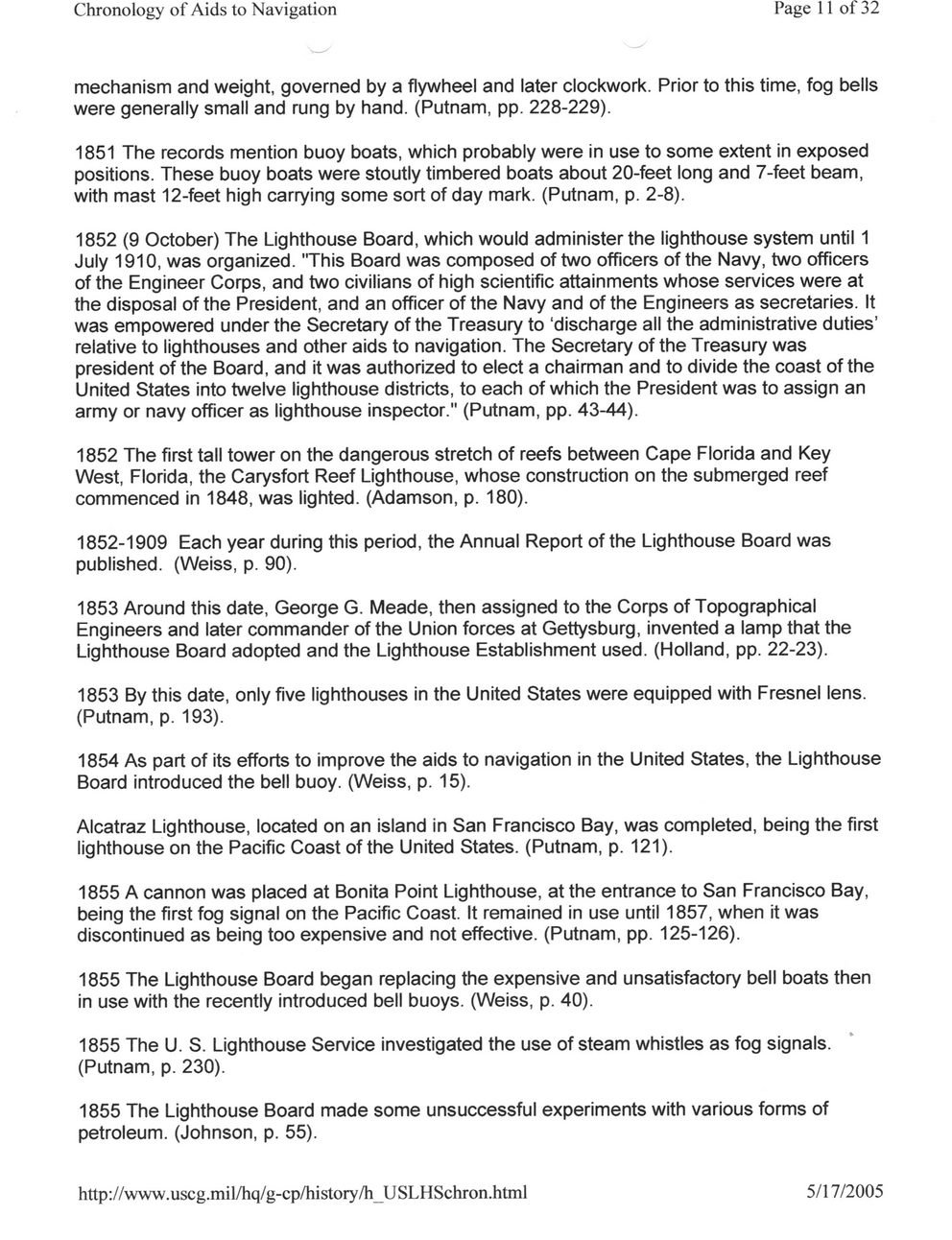This text was obtained via automated optical character recognition.
It has not been edited and may therefore contain several errors.
Chronology of Aids to Navigation Page 11 of 32 mechanism and weight, governed by a flywheel and later clockwork. Prior to this time, fog bells were generally small and rung by hand. (Putnam, pp. 228-229). 1851 The records mention buoy boats, which probably were in use to some extent in exposed positions. These buoy boats were stoutly timbered boats about 20-feet long and 7-feet beam, with mast 12-feet high carrying some sort of day mark. (Putnam, p. 2-8). 1852 (9 October) The Lighthouse Board, which would administer the lighthouse system until 1 July 1910, was organized. "This Board was composed of two officers of the Navy, two officers of the Engineer Corps, and two civilians of high scientific attainments whose services were at the disposal of the President, and an officer of the Navy and of the Engineers as secretaries. It was empowered under the Secretary of the Treasury to ‘discharge all the administrative duties’ relative to lighthouses and other aids to navigation. The Secretary of the Treasury was president of the Board, and it was authorized to elect a chairman and to divide the coast of the United States into twelve lighthouse districts, to each of which the President was to assign an army or navy officer as lighthouse inspector." (Putnam, pp. 43-44). 1852 The first tall tower on the dangerous stretch of reefs between Cape Florida and Key West, Florida, the Carysfort Reef Lighthouse, whose construction on the submerged reef commenced in 1848, was lighted. (Adamson, p. 180). 1852-1909 Each year during this period, the Annual Report of the Lighthouse Board was published. (Weiss, p. 90). 1853 Around this date, George G. Meade, then assigned to the Corps of Topographical Engineers and later commander of the Union forces at Gettysburg, invented a lamp that the Lighthouse Board adopted and the Lighthouse Establishment used. (Holland, pp. 22-23). 1853 By this date, only five lighthouses in the United States were equipped with Fresnel lens. (Putnam, p. 193). 1854 As part of its efforts to improve the aids to navigation in the United States, the Lighthouse Board introduced the bell buoy. (Weiss, p. 15). Alcatraz Lighthouse, located on an island in San Francisco Bay, was completed, being the first lighthouse on the Pacific Coast of the United States. (Putnam, p. 121). 1855 A cannon was placed at Bonita Point Lighthouse, at the entrance to San Francisco Bay, being the first fog signal on the Pacific Coast. It remained in use until 1857, when it was discontinued as being too expensive and not effective. (Putnam, pp. 125-126). 1855 The Lighthouse Board began replacing the expensive and unsatisfactory bell boats then in use with the recently introduced bell buoys. (Weiss, p. 40). 1855 The U. S. Lighthouse Service investigated the use of steam whistles as fog signals. (Putnam, p. 230). 1855 The Lighthouse Board made some unsuccessful experiments with various forms of petroleum. (Johnson, p. 55). http://www.uscg.mil/hq/g-cp/history/h_USLHSchron.html 5/17/2005

Lighthouses Chronology-of-Aids-to-Navigation-(11)